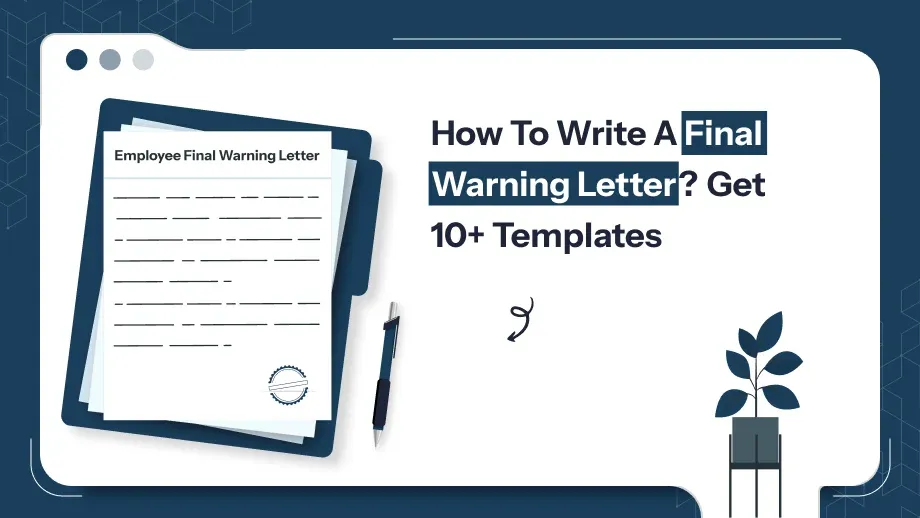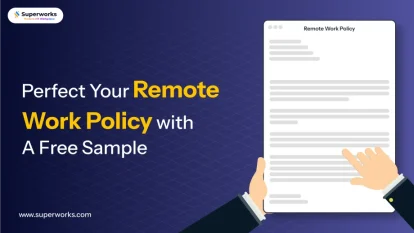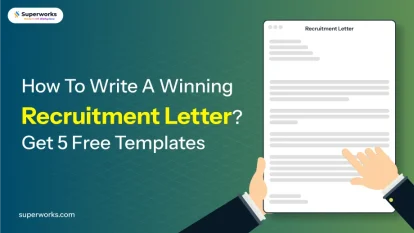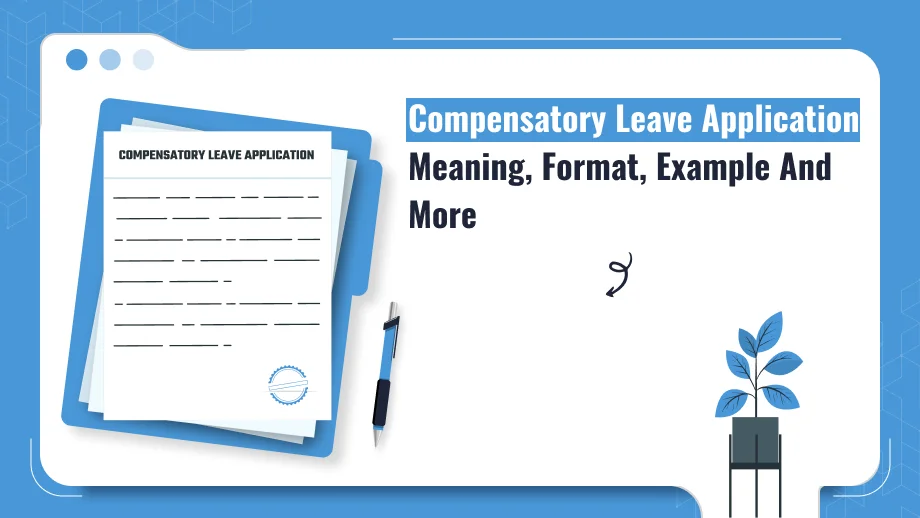Start by reviewing past warnings and documented discussions. Then, write a letter of final warning that clearly explains the issue, references previous meetings or written warnings, and outlines specific corrective measures expected. Always include the potential consequences, like termination, if there's no improvement. Deliver it in a one-on-one meeting, followed by a copy sent via email or HR records.
Grab a chance to avail 6 Months of Performance Module for FREE
Book a free demo session & learn more about it!
-
Will customized solution for your needs
-
Empowering users with user-friendly features
-
Driving success across diverse industries, everywhere.
Grab a chance to avail 6 Months of Performance Module for FREE
Book a free demo session & learn more about it!
Superworks
Modern HR Workplace
Your Partner in the entire Employee Life Cycle
From recruitment to retirement manage every stage of employee lifecycle with ease.


Seamless onboarding & offboarding
Automated compliance & payroll
Track performance & engagement
How To Write A Final Warning Letter? Get 10+ Templates
- warning letter format for employee
- 9 min read
- August 4, 2023
A final warning letter is the last formal step before firing an employee. HR sector uses it when previous verbal and written warnings didn’t bring results. It’s meant to give the employee one last chance to fix their behavior or performance before facing serious consequences like termination.
HR managers often struggle with how to write one the right way, regardless of whether it is a poor performance warning letter or otherwise. What should the letter state? What tone should it take? How much prior notice should be documented?
The answers matter. A poorly written letter can cause confusion, legal problems, or even hurt the company culture.
This guide breaks it all down. You’ll learn:
- What a final warning letter actually means
- The best practices HR teams should follow before and after sending it
- And 10+ editable templates for different situations—like poor performance, misconduct, or attendance issues
By the end, you’ll know how to write a clear, legal, and firm final warning letter without making it personal or emotional.
- Meaning of Final Warning Letter
- Things to Keep in Mind While Writing a Final Warning Letter to Employees
- 10+ Final Warning Letter Template
- 1. Final Warning Letter for Disruptive Team Collaboration
- 2. Final Warning Letter for Policy Violation
- 3. Final Warning Letter for Failure to Follow Instructions
- 4. Final Warning for Improper Conduct in Meetings
- 5. Final Warning for Ignoring Safety Procedures
- 6. Final Warning for Using Unauthorized Tools or Software
- 7. Final Warning for Incomplete Tasks and Missed Deadlines
- 8. Final Warning for Offensive Comments to Colleagues
- 9. Final Warning for Unauthorized Use of Company Property
- 10. Final Warning for Unprofessional Email Communication
- Wrap Up,
Meaning of Final Warning Letter
A letter of final warning is a written notice sent to an employee when their behavior or performance continues to be a problem, even after previous verbal or written warnings. It’s not the first step in the disciplinary process. It usually follows:
- A verbal warning- Where you just verbally warn your letter
- One or more written warnings- Where you are warning your employees in written format.
The goal is not to punish but to inform the employee [in their employment status] that their actions have had too much negative impact on the workplace. The letter outlines the employee’s actions that led to this point and what will happen if there’s no improvement.
Note:You can download directly from here and edit as per your need.
When Do You Send a Final Warning Letter?
A final warning letter from HR to the employee is sent when:
- They’ve ignored past warnings and continued poor performance
- There’s been misconduct that’s serious but not severe enough for immediate termination
- Their behavior is affecting others or damaging the working environment
- There have been too many leaves or repeated breaches of policy that the company sets!
What Should the Letter Include?
Here are the following points every final warning letter format to employee should cover:
- A summary of the employee’s work ethic and previous meetings
- A reference to written warnings or verbal discussions
- A clear description of the incident or disciplinary issue
- Expectations for positive changes and corrective measures
- A time duration for improvement
- What disciplinary action (including termination) may follow if there’s no progress
- Offer of support or help if needed
- Mention that this will be kept on record
The tone should stay professional and neutral. This is a formal letter, not a personal opinion. It’s about protecting the company, not attacking the employee.
Things to Keep in Mind While Writing a Final Warning Letter to Employees
Before you write the letter of final warning, make sure you’ve done everything by the book. This letter isn’t just a piece of paper—it’s an official employee warning notice that can impact both the employee’s work ethics and your company policy.
1. Review Previous Warnings
Check if there were prior notices, verbal warnings, or written warnings issued earlier. You need a clear trail that shows the employee was warned multiple times. This shows fairness and protects your organization in case of legal action.
2. Stick to Facts, Not Feelings
The letter should focus on the employee’s actions, not assumptions or emotions. If there was a disciplinary issue, mention what happened, when, and how it broke company rules. Be specific about the incident and keep your language neutral.
3. Include a Clear Warning Letter Format
Your warning letter format should include:
- Date of the letter
- Name of the employee
- Reason for the warning
- Details of previous meetings and discussions
- Corrective measures expected
- A set time duration for improvement
- Mention of possible outcomes, including termination
This structure ensures the letter is complete and serves its purpose.
4. Mention the Consequences
Let the employee in the office know that if they don’t show positive changes, they could face termination or other punishment. Be clear in the attendance warning letter or else, but not threatening. The letter should guide, not attack.
5. Keep the Process Legal and Consistent
The way you send warning letters matters. The process should follow your company’s punishment system and be the same for all employees. That means no skipping steps or treating cases differently.
Also, the letter states that a copy will be added to the employee’s record. This makes it an official part of the disciplinary action process.
10+ Final Warning Letter Template
Here are 10+ ready-to-use letter templates for employees. These templates are written to handle common issues like performance, misconduct, or not following company policy. You can copy, paste, and edit them based on the specific situation in your workplace.
1. Final Warning Letter for Disruptive Team Collaboration
Subject: Final Warning – Disruption in Team Collaboration
Date: [Insert Date]
To: [Employee Name]
Department: [Department Name]
This is a final warning regarding ongoing disruptions in collaborative team efforts. It has been observed, and previously discussed, that your unwillingness to participate constructively in group tasks has slowed down progress and affected team morale.
Your approach to shared responsibilities has created confusion, delayed timelines, and impacted the overall performance of the team. These issues were addressed during previous meetings, and a written warning was issued on [insert date].
Moving forward, we expect you to engage respectfully with your colleagues and support the workflow of joint projects. Continued disregard may lead to serious disciplinary action, including the possibility of termination.
Please treat this as a formal employee warning notice and take the necessary corrective measures.
Sincerely,
[Manager Name]
[Designation]
[Company Name]
2. Final Warning Letter for Policy Violation
Subject: Final Warning for Breach of Company Policy
Date: [Insert Date]
To: [Employee Name]
You have breached our company policy on multiple occasions, including [mention the breach]. This letter follows prior warnings and serves as a final warning before further notice.
We expect your full cooperation and corrective measures starting immediately. Failing to do so may result in disciplinary action up to and including termination.
Sincerely,
[Manager Name]
[Title]
[Company]
3. Final Warning Letter for Failure to Follow Instructions
Subject: Final Warning – Non-Compliance with Instructions
Date: [Insert Date]
To: [Employee Name]
Despite being told to follow specific steps during [incident], you failed to comply. This goes against your responsibilities and disrupts the working environment.
We have already issued a written warning regarding this matter. This final warning expects positive changes in your work methods.
If the same issue happens again, we may take legal action or proceed with termination.
Sincerely,
[HR Department]
[Company Name]
4. Final Warning for Improper Conduct in Meetings
Subject: Final Warning for Unprofessional Behavior During Meetings
Date: [Insert Date]
To: [Employee Name]
Your conduct during team meetings has not reflected acceptable workplace behavior. You were previously warned about the tone and language used, especially on [mention date or incident].
This warning letter to employee serves as the last formal notice. Further incidents will lead to termination without further notice.
Sincerely,
[Your Name]
[Role]
Make your HR tasks much easier with customizable letters!
Get instant access click & download now!
5. Final Warning for Ignoring Safety Procedures
Subject: Final Warning – Ignoring Safety Guidelines
Date: [Insert Date]
To: [Employee Name]
Safety is a non-negotiable priority at [Company Name]. Your repeated failure to follow safety rules, even after a verbal warning and a written warning letter, cannot be ignored.
This is your final warning. Immediate corrective measures must be taken.
Sincerely,
[Manager Name]
Subject: Final Warning – Use of Unauthorized Tools
Date: [Insert Date]
To: [Employee Name]
You were found using software not approved by the company. This breach of our IT policy was discussed in a previous meeting, and a warning letter was issued on [insert date].
This is a letter consisting of a final warning. Using such tools again may lead to termination or other disciplinary action.
Sincerely,
[IT Department Head]
7. Final Warning for Incomplete Tasks and Missed Deadlines
Subject: Final Warning – Consistent Missed Deadlines
Date: [Insert Date]
To: [Employee Name]
Your tasks continue to be incomplete or delayed beyond the agreed time duration. This issue has already been discussed and documented.
We issue such a letter, expecting strict improvement. Future delays will result in disciplinary action.
Sincerely,
[Team Lead]
8. Final Warning for Offensive Comments to Colleagues
Subject: Final Warning – Unacceptable Comments to Team Members
Date: [Insert Date]
To: [Employee Name]
You made inappropriate comments during the meeting held on [mention date]. This type of behavior goes against our company culture and has caused a negative impact.
As this is a final warning, any repeat behavior will lead to immediate termination.
Sincerely,
[HR Manager]
Subject: Final Warning – Unauthorized Use of Property
Date: [Insert Date]
To: [Employee Name]
You used company equipment for personal work without permission. This was discussed with you earlier in a verbal warning and noted in a written warning letter.
This employee warning notice serves as the final step before we consider termination or other actions.
Sincerely,
[Admin Department]
10. Final Warning for Unprofessional Email Communication
Subject: Final Warning – Email Misconduct
Date: [Insert Date]
To: [Employee Name]
Your recent email to [Name] on [Date] contained unprofessional language. It violated our internal communication guidelines and was addressed in a previous meeting.
This is a final warning. All future communication must follow the organization’s tone and expectations.
Sincerely,
[Manager Name]
Wrap Up,
A final warning letter is more than just a document – it’s part of a fair and structured disciplinary process that protects both the employee and the organization. It helps HR stay consistent, transparent, and legally safe while addressing behavior or performance issues that haven’t improved despite prior notice.
When writing one, stick to facts, stay professional, and always follow your company policy. Clear documentation, a proper warning letter format, and a calm tone can prevent misunderstandings and keep the door open for positive changes, which is the goal.
Some HR teams streamline this entire process using tools like HRMS & payroll software that help log warnings, monitor employee performance, and track corrective measures over time. A few HR platforms even offer built-in templates and reminders to simplify routine tasks without missing a step.
Whether you’re managing employee warnings, performance reviews, or internal notices, having support like that in place can make a real difference.
FAQs
How to give a final written warning to an employee?
Does final warning mean termination?
No, but it's the last step before it. A final warning gives the employee one final chance to fix the issue. If they continue the same behavior or poor performance, it can lead to termination without further notice. It’s a formal notice that the company has exhausted all prior steps, like verbal warning or written warning letter.
How many warnings before final written warning?
It depends on your company policy. Most companies issue a verbal warning first, followed by a written warning, before moving to a final written warning. Some cases—especially serious misconduct—may skip steps. Always make sure the employee warning notice trail is well-documented to stay legally compliant.
How to write a disciplinary outcome letter?
Summarize the investigation, decision made, and next steps. Start with the reason for the disciplinary process, the outcome (e.g., final warning, demotion, or no action), and what the employee is expected to do moving forward. Keep the tone neutral and stick to the facts. Attach any supporting documents and reference the relevant company rules or procedures.
How do I write a warning letter to an employee for carelessness?
Be specific about what the employee did and how it affected work. Mention the incident, dates, and any past warnings. Then clearly state the expectations going forward and the time duration for improvement. Use a standard warning letter format and make sure it's signed and recorded for future reference.



